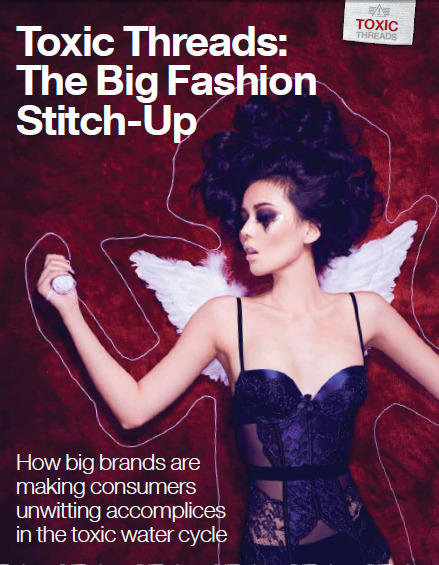 I hate Greenpeace. My motives being they’re a publicity multinational that promotes unscientific stances and lies on a regular basis. They’re anti-GMOs (outside the US), anti-nuclear energy and they’re against stem cell research (just like the Catholic Church).
I hate Greenpeace. My motives being they’re a publicity multinational that promotes unscientific stances and lies on a regular basis. They’re anti-GMOs (outside the US), anti-nuclear energy and they’re against stem cell research (just like the Catholic Church).
They also have this modus operandi of going after big innocent enterprises and defame them with fabricated reports and impressive propaganda. They did it to Shell, which resulted in 50 incidents against gas stations throughout Germany, including two bomb attacks and one with firearms [PDF].
So I was suspicious when Greenpeace started to trash Zara and other fashion brands saying they were making cancer-producing clothes.
It turns out that the study on which Greenpeace relies to make these accusations is its Detox report [PDF], which -surprise, surprise- has proved a pamphlet rather than a serious study.
Chemist and Chemistry teacher Deborah García Bello tells us in her blog, DimetilSulfuro:
On the Detox report, I came across that the sampling was based on the analysis of only 10 different garments (thus not a representative method) and that the only chemical kind of information contained there are some tables where concentration values appear detected in each of the ten Zara garments, not including any error margin (which is associated with any analytical technique anytime), only the detection limit. To find more information on the methods and analytical techniques employed (issue not mentioned in Detox) I had to resort to an initial report by Greenpeace’s own laboratories in the UK.
So, just to be clear: the study is invalid. It was a non-peer reviewed fabrication, that does not meet minimum requirements to be considered a true scientific study.
And it doesn’t stop there. From the results of the Detox report, it does not follow that whole oncology apocalypse Greenpeace predicted. Not even close to it:
For all of us to get along I will define a set of analytical terms that will help us understand the data of the report:
– Limit of Detection (LOD): minimum amount or concentration of a substance that can be reliably detected by a specific analytical method (IUPAC 1995)
-Representative method: the number of samples analyzed, as well as taking them in different places and at different times, has to ensure that the test result has an appropriate level of confidence and a margin of error defined.
Consider the results presented for the three types of substances:
Phthalates
Phthalates are plasticizers, used to provide elasticity to certain polymers, and therefore are used in printed plastics.
Only one of the ten samples was analyzed, since apparently none of the other nine had a printing technique that could contain phthalates. The LOD technique is 3ppm (equivalent to 3 mg per kg of sample) and out of the 9 types of phthalates analyzed only one type (DEHP) was detected in a concentration of 3.8 ppm (very close to LOD) and without giving any error margin (which is impossible, and even more so being in an amount so close to the LOD).
The analysis of a single piece obviously does not correspond to a representative method, which by definition requires an analytical method, therefore lacks scientific validity.
Currently, no studies have demonstrated toxicity regarding the development of reproductive organs in humans (the toxicity attributed to them) and therefore the legislation, as a precaution, only concerns toys and child care products; i.e. there is no legislation within the textile, so Zara is not committing any illegality.
Amines from azocolourants
Azocolourants are used as colorants in the textile and may be degraded to aromatic amines in reducing agents like those fostered by certain intestinal bacteria.
Of the ten samples only nine were analyzed, of which only two gave a result above the LOD (5ppm), and again without an accompanying margin of error attributed to the methods and techniques used in the analysis. The results were 9ppm and 7ppm o-dianisidine.
European legislation states that no concentrations of amines in should be used above 30ppm, so again Zara is not committing any illegality. After multiple studies it hasn’t been scientifically proven that o-dianisidine cause cancer (the toxicity attributed to it), it is only seen as a suspect substance.
Furthermore, if the MLA (maximum limit allowed) is 30ppm, the technique should have an LOD ten times lower, i.e. 3ppm, which Greenpeace’s analysis fails.
NPEs (nonylphenol ethoxylates)
These substances are used as surfactants (they downgrade the surface tension of water so that it penetrates the fabric) and facilitate the dyeing, bleaching and wet treatments of other garment.
The ten Zara samples were analyzed, and six of them had a positive enough above the LOD (1ppm). Although the sample is not representative, it can be assumed that there is evidence that some Zara products contain such a substance.
On the other hand, there are no regulations preventing the use of such substance in the textile, so again Zara is not committing any illegality. The toxicity attributed to these compounds is that when they decompose they release nonylphenol, which acts as a fish hormone disruptor.
So, not only they presented a false report as if it was real, but also the report results set Zara free from any illegality (in these matters).
Greenpeace made this up.
And in the process they have defamed a clothing brand completely innocent of the charges for which it’s being accused, they mopped the floor with the image and good name of a legitimate and legal business and have deceived the whole world.
Zara is definitely a fashion victim. Greenpeace‘s fashion of going throughout the world making up results that favor their ideological agenda, although there’s no science behind their claims.
